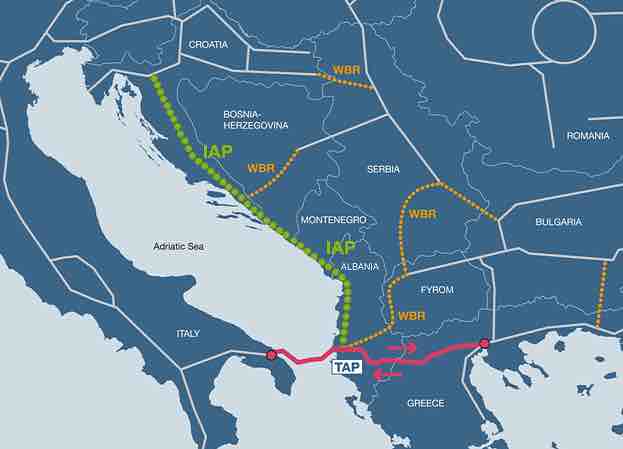May 2016, Vol. 243, No. 5
Web Exclusive
Greek Pipeline Breakthrough to Challenge Russian Gas Dominance

After years of debate, political jockeying and acrimony, a major pipeline project to bring natural gas to Southern Europe has broken ground.
The Trans-Adriatic Pipeline (TAP) will connect the Caspian Sea to European markets, providing Europe with another large source of natural gas that will help the continent diversify away from Russia. The route begins at the Caspian Sea in Azerbaijan, where the South Caucuses Pipeline will carry Caspian gas from the large Shah Deniz-2 gas field, delivering it to the border with Turkey. From Turkey the gas will tie into the Trans Anatolian Pipeline (TANAP), which will take the gas across Turkey to the border with Greece where it will meet up with the aforementioned Trans-Adriatic Pipeline. The Caspian gas will then travel through TAP across Greece, beneath the Adriatic Sea and onto Italy.
The pipeline projects are part of what is often referred to as the “Southern Corridor” for European gas. For years Europe has pressed for a gas pipeline through the southern corridor that would offer it an alternative to Russian gas. But TAP was not always an inevitability – before the consortium of companies took up the project, the European Union favored the Nabucco Pipeline, which instead of sending Caspian gas to Italy, would have resulted in a pipeline snaking its way through the Balkans to Central Europe.
And back when Nabucco was in vogue, Russia pushed hard for its own route through Southern Europe. The so-called South Stream Pipeline would have sent Russian gas beneath the Black Sea to Bulgaria. European regulators worked hard to derail that pipeline on anti-competition grounds. Shortly after the death of South Stream, and following in the wake of Russia’s standoff with Europe over its incursion into Ukraine, Russia pushed the “Turkish Stream” project, which would have sent Russian gas to Turkey and then onto Southern Europe. But the project was more of an idea than a reality, and due to a set of differences between Russia and Turkey, not the least of which was the cost of the pipeline and how it would be paid for, the project never really went anywhere.
The complexity of pipeline politics and the web of pipeline routes can be confusing, but suffice it to say the Turkish-Greece-Italy route has won out, through the TANAP and TAP pipelines. On May 17, TAP broke ground in Thessaloniki, Greece. Construction will take several years, but when the $45 billion project is completed in 2020, it will deliver 10 billion cubic meters per year of natural gas from the Caspian Sea to Europe.
Greek Prime Minister Alexis Tsipras was in attendance for the groundbreaking event, as were top officials from Georgia, Azerbaijan, Albania, the EU and even the U.S. State Department. Each have their own reasons for supporting the project. The project developers – BP, the Azerbaijan state-owned oil company SOCAR, and others – obviously have direct profit motives in mind. The national governments see economic opportunities through construction and transit fees. For Greece, in particular, the EU sees TAP as providing an economic stimulus to the indebted nation at a time when debt negotiations continue to torment both sides.
From the perspective of the U.S. government, TAP will reduce Europe’s dependence on and vulnerability to Russia; in essence, it is a major geopolitical victory. U.S. Secretary of State John Kerry, in a congratulatory letter to Greece’s Prime Minister, said that TAP is a “prime example of infrastructure that enhances European energy security.”
Diversity of supply has become one of Europe’s key energy security objectives, along with building an “energy union” between EU member states.
“A single European energy market will allow us to increase our security of supply by allowing energy to flow freely across our borders,” European Commission Vice President for Energy Union Maroš Šef?ovi? said at the ceremony. “It will allow us to better negotiate with our external partners, given that the EU is the largest energy importer in the world.”
By Nick Cunningham of Oilprice.com





Comments